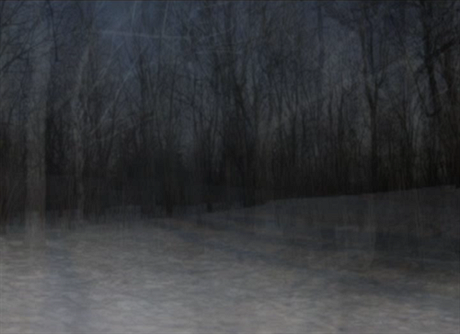The Prague Biennale has opened at a new location for its almost four-month exhibition of diverse trends to be found across the international world of contemporary art. Hungarian and Romanian painting, Czech and Polish photography, Canadian video and conceptual art all share office space with a wide range of work from India, the US, the UK and other global art scenes.
Like past biennales, the work on display is mixed in quality, with some outstanding painting, sculpture, video and conceptual art offset by pieces that would not be out of place in an exhibition of student work.
After three biennales in the massive, open industrial space of Karlin Hall, the country’s biggest art event has moved across town to the former Microna aircraft engine factory and office building in Prague 4–Modřany.
While the site is further from the center and does not have the same flexibility as a large open space that can be divided at the curators’ will, it makes up for these drawbacks in its uniqueness and the novel way it allows visitors to view the art on display.
Entering the otherwise empty building is like stepping through a time warp where a framed photograph of Brezhnev hanging on the wall would hardly be surprising. The former industrial space, though beautiful, could have been a derelict factory anywhere, whereas this dingy building with its fluorescent lights and stained carpets, not to mention the surrounding neighborhood spotted with similar relics of the Czechoslovak past, evokes a much more specific time and place.
Beyond narrative
One of the most striking aspects of this year’s exhibition is the video art. From entirely different sections of the show it is evident that the medium is undergoing an evolution away from being a narrative art to having a narrower, more visual focus. New technologies have likewise expanded artistic possibilities, as the days of a large TV on a table with a VCR are plainly behind us.
Cécile Martin is a trained architect who has worked primarily as a photographer in Montreal, Canada, and sees the new direction and possibilities being undertaken in video. Her project “Panoramics_Mont-Royal #3,” commissioned specifically for the Prague Biennale, is an outgrowth of her panoramic photography transferred to the domain of video.
“For me it was very difficult to make the transition from photography to this time-based medium,” Martin told Czech Position, adding that it required a change in her way of thinking and working that took two years to achieve.
The panoramic images of the forest, displayed on three small screens suspended from the ceiling, share more with painting and photography than what video art has come to be known for. Martin cites the influence of the Futurists and their focus on showing the continuum of time and motion.
“Now the new media has gone beyond narrative,” Martin said. “For a long time it was about the fact that it was very easy to find a camera. … The production was homemade. But now I think there’s a new evolution because the homemade production was very much related to personal narrative.”
Painting in video
This trend is visible elsewhere in the exhibition, such as in the work of two Indian artists, Gigi Scaria and Ranbir Kaleka, in the Crossroads: India Escalate section.
Scaria’s “Amusement Park” transplants images of skyscrapers and other spinning buildings onto a muddy, desolate lot; all shown in a bleak yet stunning black and white. Kaleka’s “Man with Cockerel” attains a much more still and serene feeling with the most overtly painterly use of video in the show.
Martin feels that video art lost its initial sense of discovery as artists began specializing in video rather than thinking of it as one medium among others. “I’m using video, but it’s only one of the mediums I use. … The most essential is the question, and the medium is accessory,” she said.
The artistic comparison that Martin finds most fitting for video art today is actually not with a visual art at all. “There is a very strong connection between sound art and video art, which is not so much video art anymore because it’s about the image, a moving image.” In her case, the connection with electronic music brought about her collaboration on this project with internationally renowned Spanish sound artist Francisco López.
There was a practical element to Martin’s contribution to the biennale being in video as well, but one that remains just as reflective of the medium’s changing role in the art world. “The curator who invited me to the Biennale knew my photography and was very interested but said that photography was very expensive to travel — it’s delicate, framed behind glass and so big and heavy. He said I had to think about something else if I wanted to come to the Biennale.”
Prague Biennale 5 / Prague Biennale Photo 2
Microna
Československého exílu 4
Prague 4–Modřany
Until Sept. 11, 2011
Daily 11 a.m. to 7 p.m.
www.praguebiennale.org

